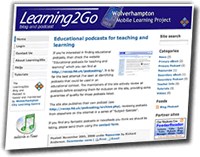New Pocket PC Freeware
/ Like I said in my last post, there hasn't been much to report in the world of PDAs as manufactures place their emphasis on smartphones instead. Although there's not much new hardware, software continues to be developed for handhelds. Here are some recently released applications (mostly games) for Pocket PCs running Windows Mobile:
Like I said in my last post, there hasn't been much to report in the world of PDAs as manufactures place their emphasis on smartphones instead. Although there's not much new hardware, software continues to be developed for handhelds. Here are some recently released applications (mostly games) for Pocket PCs running Windows Mobile:
- Arikone - Game where you connect the numbers with a line that cannot cross itself.
- Color Lines - Classic game where you place five like-colored balls in a row to make them disappear and score points.
- Delicious Plug In - Quickly bookmark and tag sites for Delcious.com from inside of Internet Explorer Mobile.
- CapSure - Take photos of what's on the handheld's screen. Great for make how-to slideshows and handouts.
- Dice - Simple random number generator 1-6.
- Loan Assist - See how interest rates affect the cost of a loan. Note: Works on WM 3 and might not work on other versions.
- Miner - A version of Minesweeper for Windows Mobile.
- Music Trainer - Improve musical score reading and accuracy. Read more about the application.
- MyEnglishFAQ - Quick reference for the English language, including commonly confused words and irregular verbs.
- Pocket Uno - Pocket PC version of the card game.
- Shift - Puzzle game where you move tiles around a board.
- Skinz Sudoku - Friendly-looking Sudoku number game.
- Sale Calculator - Figures the final price for percentage-off sales. Students could easily make their own calculator using Excel Mobile.
- SimpTimer - Display up to six timers on the screen at once.
- Skype - Free voice calls using Wi-Fi.
- Taiyoukei - Database for information about the solar system. Includes images.
- TildeTech Hangman - Simple Hangman game. You can make your own dictionaries of words.
- Vexed - Puzzle game where you move tiles to make them disappear. Try to make the goal in as few moves as possible. This is one of my favorite puzzle games!
- WM Screenshot - Another free screenshot program.
- Word Seeker - Game of concentration with nine words that need to be matched. Words that match can be the same word, a synonym, antonym, or homonym.
- And if you want to run lots more free software, buy StyleTap to run most all Palm programs, including the ones I mentioned in my previous post.





 Believe it or not, more people have access to mobile devices than desktop computers. Many handhelds can access the Internet, including cell phones, Palm handhelds, Pocket PCs, Nintendo DS's, and Sony PSPs.
Believe it or not, more people have access to mobile devices than desktop computers. Many handhelds can access the Internet, including cell phones, Palm handhelds, Pocket PCs, Nintendo DS's, and Sony PSPs.


 The second edition of Handhelds for Teachers & Administrators by Tony Vincent and Janet Caughlin is now available! You might be familiar with the first edition published four years ago. Edition 2 has been completely updated and has an added 50 pages. Besides taking you step-by-step through using Palm handhelds, Pocket PCs, iPods, and podcasting, the book gives dozens of examples of classroom use. In fact, the vignettes with teacher lesson idea and their insights into handheld computing is my favorite chapter. There's also a chapter with school administrators telling you all about how they use handhelds to do their jobs better.
The second edition of Handhelds for Teachers & Administrators by Tony Vincent and Janet Caughlin is now available! You might be familiar with the first edition published four years ago. Edition 2 has been completely updated and has an added 50 pages. Besides taking you step-by-step through using Palm handhelds, Pocket PCs, iPods, and podcasting, the book gives dozens of examples of classroom use. In fact, the vignettes with teacher lesson idea and their insights into handheld computing is my favorite chapter. There's also a chapter with school administrators telling you all about how they use handhelds to do their jobs better.



 Clocks will be "springing forward" a few weeks earlier this year thanks to the
Clocks will be "springing forward" a few weeks earlier this year thanks to the  There's a new
There's a new 
 Here's a new freeware math game for Palm and Windows Mobile users:
Here's a new freeware math game for Palm and Windows Mobile users: 


 The Wolverhampton Local Authority in the U.K. has been using Pocket PCs for a few years. They call their project
The Wolverhampton Local Authority in the U.K. has been using Pocket PCs for a few years. They call their project 
 The second day of the
The second day of the  I spoke about my five reasons for loving handheld computers. These include freeing the computer lab, teacher tools, free software, engaging activities, and animations. I've given this speech many times in the states, but this was first time abroad and by far the shortest time I've had to showcase why handhelds are great for teaching and learning. Aside from a few other speakers like Gerry Gray, I was the only one to really talk about hardware and software. In fact, most speakers emphasized that its not about the technology and all about learning. So true. However, teachers need to know the capabilities of the devices so they can plan learning activities! Most delegates didn't realize that they can run Palm OS applications using StyleTap and were very excited with what they saw. I wish I had more time to share other pieces of software.
I spoke about my five reasons for loving handheld computers. These include freeing the computer lab, teacher tools, free software, engaging activities, and animations. I've given this speech many times in the states, but this was first time abroad and by far the shortest time I've had to showcase why handhelds are great for teaching and learning. Aside from a few other speakers like Gerry Gray, I was the only one to really talk about hardware and software. In fact, most speakers emphasized that its not about the technology and all about learning. So true. However, teachers need to know the capabilities of the devices so they can plan learning activities! Most delegates didn't realize that they can run Palm OS applications using StyleTap and were very excited with what they saw. I wish I had more time to share other pieces of software.